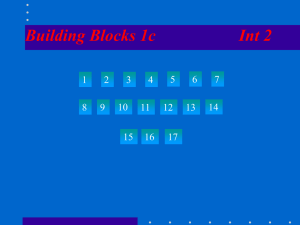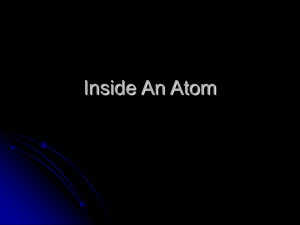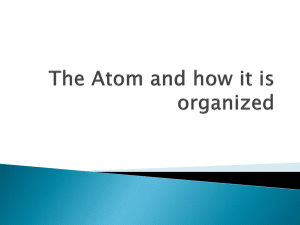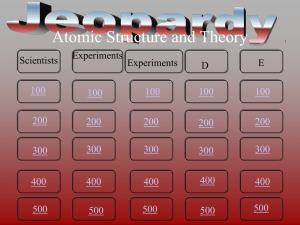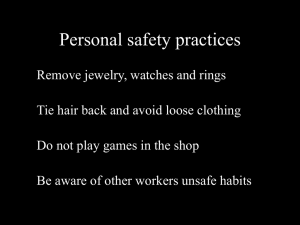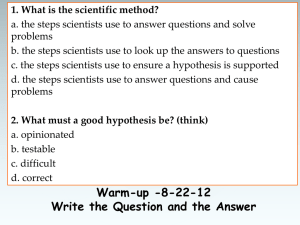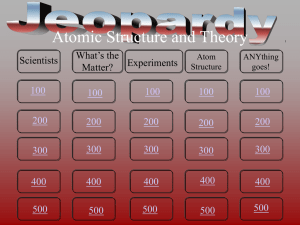Bell Work 9/21 & 9/22 * Pgs. 109
advertisement
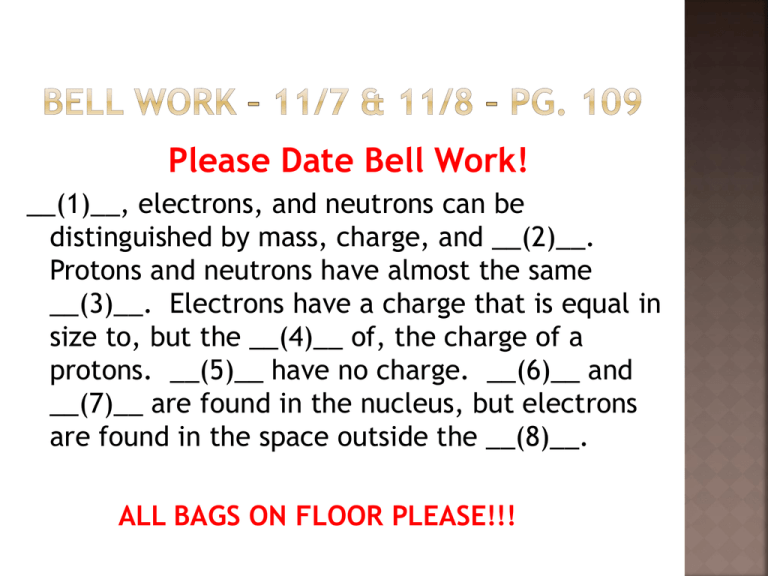
Please Date Bell Work! __(1)__, electrons, and neutrons can be distinguished by mass, charge, and __(2)__. Protons and neutrons have almost the same __(3)__. Electrons have a charge that is equal in size to, but the __(4)__ of, the charge of a protons. __(5)__ have no charge. __(6)__ and __(7)__ are found in the nucleus, but electrons are found in the space outside the __(8)__. ALL BAGS ON FLOOR PLEASE!!! All bags on floor please!!! Atoms of different elements have different numbers of __(1)__. The sulfur shown in the figure is assigned atomic number __(2)__ because a sulfur atom has 16 __(3)__. You can use atomic numbers to refer to elements, like names and symbols because each element has a unique __(4)__. Each positive charge in an atom is __(5)__ by a __(6)__ because atoms are __(7)__. Please date bell work! All bags on floor please!!! Protons, __(1)__, and __(3)__ can be distinguished by mass, __(3)__, and location in an __(4)__. Protons and neutrons have almost the same __(5)__. Electrons have a charge that is equal in size to, but the opposite of, the charge of a __(6)__. Please date bell work! All bags on floor please!!! Identify the symbol, and amount of protons, neutrons, and electrons for the following atoms: 1) Neon Mass Number = 20 2) Aluminum Mass Number = 27 3) Potassium Mass Number = 40 Please date bell work! All bags on the floor please!!! 1) What are the three subatomic particles? 2) Which two subatomic particles are in the nucleus? 3) What is atomic number? 4) How do you find the mass number of an atom? All bags on floor please!!! Identify the symbol, and amount of protons, neutrons, and electrons for the following atoms: 1) Magnesium 2) Mercury 3) Zirconium Please date bell work! 1) 2) 3) 4) 5) ALL BAGS ON FLOOR PLEASE!!! What is the charge and location of a proton? What is the charge and location of an electron? What is the charge and location of a neutron? What information does the atomic number give us? How can we find the number of neutrons in an atom? ALL BAGS ON FLOOR PLEASE!!! An __(1)__ can move from one energy level to another when the atom __(2)__ energy. An electron may move up two energy levels if it gains the right amount of __(3)__. An electron in a higher energy level may move down if it __(4)__ the right amount of __(5)__. The size of the jump between __(6)__ determine the amount of __(7)__ gained or lost. ALL BAGS ON FLOOR PLEASE!!! Scientists must deal with the __(1)__ when trying to predict the locations and motions of __(2)__ in atoms. An __(3)__ cloud is a visual model of the most likely locations for electrons in an atom. The cloud is __(4)__ at those locations where the probability of finding an electron is __(5)__. Scientists use the electron cloud model to describe the __(6)__ locations of __(7)__ around the nucleus. ALL BAGS ON FLOOR PLEASE!!! The __(1)__ number tells you the number of __(2)__ in the atom’s nucleus. It does not give you any information about the number of __(3)__ in an atom. For that information, you need to the atom’s __(4)__. The mass number of an atom is the __(5)__ of the protons and __(6)__.
